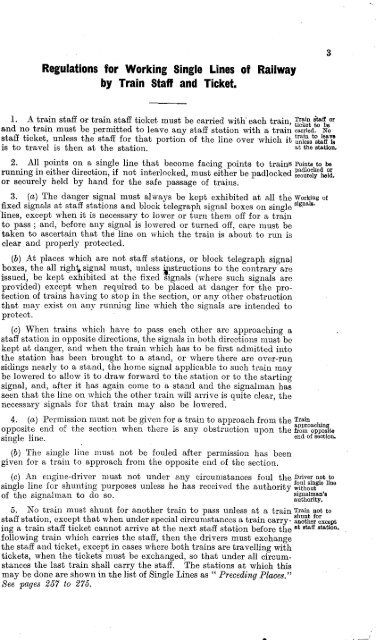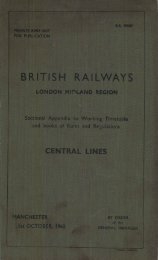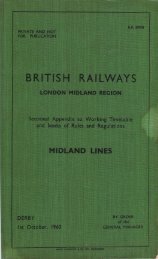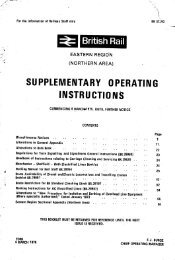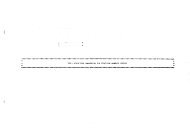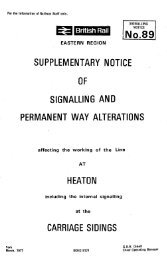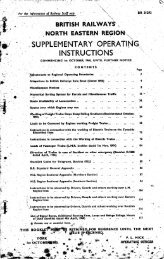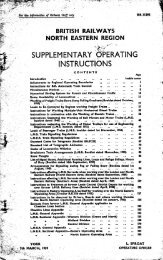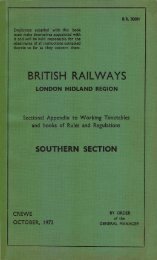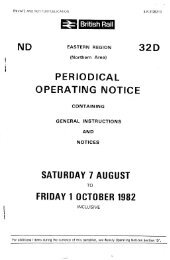general instructions. - Limit Of Shunt
general instructions. - Limit Of Shunt
general instructions. - Limit Of Shunt
Create successful ePaper yourself
Turn your PDF publications into a flip-book with our unique Google optimized e-Paper software.
Regulations for Working Single Lines of Railway<br />
by Train Staff and Ticket.<br />
1. A train staff or train staff ticket must be carried with each train, tilthe°r<br />
and no train must be permitted to leave any staff station with a train carried. No<br />
staff ticket, unless the staff for that portion of the line over which it t<br />
is to travel is then at the station. a t the station.<br />
u<br />
). 2. All points on a single line that become facing points to trains Points to be<br />
;1 running in either direction, if not interlocked, must either be padlocked :).edurioelkye<br />
1or<br />
securely held by hand for the safe passage of trains.<br />
:ss 3. (a) The danger signal must always be kept exhibited at all the lyorking of<br />
. t°<br />
fstl<br />
lines, except when it is necessary to lower or turn them off for a train<br />
ie<br />
to pass ; and, before any signal is lowered or turned off, care must be<br />
taken to ascertain that the line on which the train is about to run is<br />
xcri:<br />
clear and properly protected.<br />
e<br />
d<br />
(b) At places which are not staff stations, or block telegraph signal<br />
s<br />
boxes, the all right signal must, unless lestructions to the contrary are<br />
issued, be kept exhibited at the fixed signals (where such signals are<br />
iprovided)<br />
except when required to be placed at danger for the pro-<br />
gtection<br />
of trains having to stop in the section, or any other obstruction<br />
nthat<br />
may exist on any running line which the signals are intended to<br />
a<br />
protect.<br />
l (c) When trains which have to pass each other are approaching a<br />
s staff station in opposite directions, the signals in both directions must be<br />
a<br />
kept at danger, and when the train which has to be first admitted into<br />
the station has been brought to a stand, or where there are over-run<br />
t<br />
sidings nearly to a stand, the home signal applicable to such train may<br />
sbe<br />
lowered to allow it to ,draw forward to the station or to the starting<br />
tsignal,<br />
and, after it has again come to a stand and the signalman has<br />
aseen<br />
that the line on which the other train will arrive is quite clear, the<br />
f<br />
necessary signals for that train may also be lowered.<br />
f 4. (a) Permission must not be ,given for a train to approach from the Train oachin<br />
sopposite<br />
end of the section when there is any obstruction upon the VO<br />
tPsingle<br />
line.. e n d of section.<br />
ara<br />
(b) The single line must not be fouled after permission has been<br />
tr<br />
given opposite for a train to approach from the opposite end of the section.<br />
i<br />
not to<br />
(c) An engine-driver must not under any circumstances foul the D<br />
osingle<br />
line for shunting purposes unless he has received the authority C4h,tc<br />
r<br />
nof<br />
the signalman to do so. s i g n a l m a n ' s<br />
authority.<br />
i<br />
s<br />
5. ver No train i must shunt for another train to pass unless at a train Tfain<br />
astaff<br />
t l<br />
station, except that when under special circumstances a train carry- another%xcept<br />
i<br />
s<br />
ning<br />
a train staff ticket cannot arrive at the next staff station before the at n taff station.<br />
d following train which carries the staff, then the drivers must exchange o<br />
the staff and ticket, except in cases where both trains are travelling with t<br />
btickets,<br />
when the tickets must be exchanged, so that under all circum- t<br />
lstances<br />
the last train shall carry the staff. The stations at which this o<br />
omay<br />
be done are shown in the list of Single Lines as "<br />
cSee<br />
Preceding pages 257 to 275. P l a c e s . "<br />
k<br />
t<br />
e<br />
l<br />
3<br />
•


